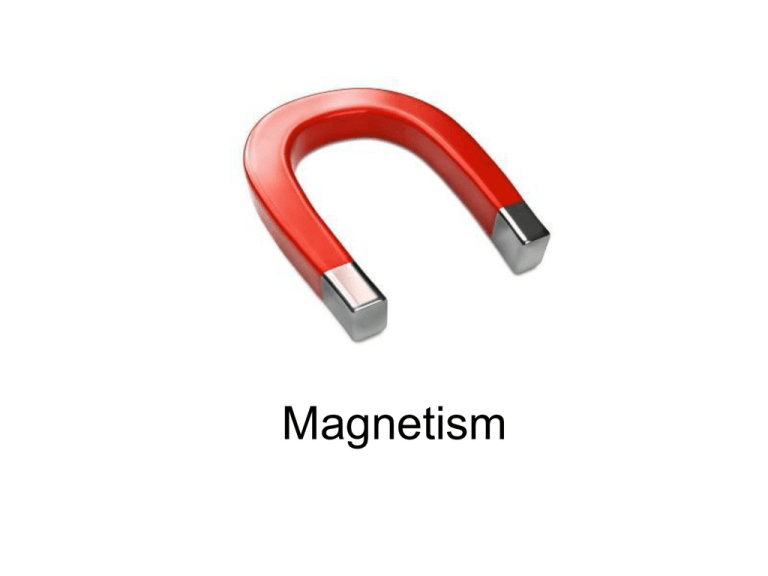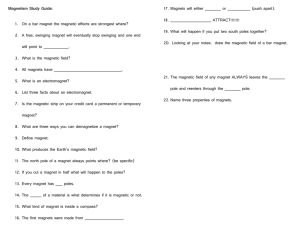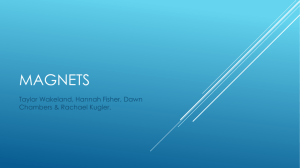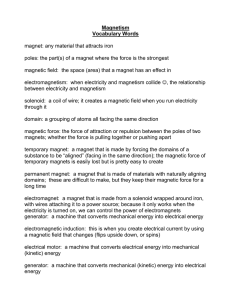Magnetism
advertisement

Magnetism Three Properties of Magnets 1. Magnets have poles; a north pole and a south pole. 2. Magnets exert forces; they can push or pull other magnets. 3. Magnets have a magnetic field around them. This is the area where the force acts. Magnetic field - surrounds magnets and exerts a force on other objects Magnetic fields also have a direction. The field lines are closest at the ends of the magnet -- the POLES - every magnet has a north and a south pole Oddly shaped magnets still have a north and a south Magnets either attract or repel each other South poles are attracted to north poles Like poles repel Unlike poles attract What happens when you bring a compass near a bar magnet? The north indicator of the compass will point toward the south pole of a magnet. This is also why a compass points north, it's lining up with the earth's magnetic poles. Sometimes the field completely flips. The north and the south poles swap places. Such reversals, recorded in the magnetism of ancient rocks, are unpredictable. They come at irregular intervals averaging about 300,000 years; the last one was 780,000 years ago. Are we overdue for another? No one knows. The magnetic North Pole is responsible for more than just the direction a compass points. It's also the source of the aurora borealis, the dramatic lights that appear when solar radiation bounces off the Earth's magnetic field. This happens at the South Pole as well. In the southern hemisphere, the lights are called the aurora australas. Make your own compass http://adventure.howstuffworks.com/outdooractivities/hiking/compass2.htm Magnetic Domains = groups of atoms with aligned poles Magnets can be temporary (like the needle used in the compass). This nail has its atoms aligned, but the effect is only temporary. You can get this affect by rubbing the nail on a magnet. Neat fact: Hitting the nail can demagnetize it, you are basically scrambling the atoms. A permanent magnet is an object made from a material that is magnetized and creates its own persistent magnetic field. An everyday example is a refrigerator magnet used to hold notes on a refrigerator door. Metals that are magnetic: nickel, iron, cobalt Things that are not magnetic: aluminum, plastic, glass Ferromagnetic - a substance such as iron in which the magnetic moments of the atoms spontaneously line up with each other, making a large net magnetic moment. Ferromagnets lose their ferromagnetism when heated above a specific temperature , because the thermal energy melts the magnetic alignment. What else can cause a ferromagnet to lose its magnetism? In 1820, it was discovered that a compass needle is affected by an electric current. Several responses to Hans Christian Oersted's observation: No way!!! For realz? Liar! Unbelievable! He went further to propose that the direction of the field changed with the direction of the current. Maglev Trains Magnetic + Levitation = maglev Maglev vehicles “float” over an electromagnetically powered fixed steel guideway and are propelled by the current with no motors, wheels, moving parts or additional energy sources. The system is environmentally friendly, energy efficient and runs in all weather conditions. http://dsc.discovery.com/vide os/extreme-engineeringseason-1-shorts-maglevtrain.html A rule was created to predict the direction of the magnetic field. It is called The Right Hand Rule Field can either be clockwise or counterclockwise, depending on the direction of the current. WORD CHECK 1. Magnetic Field 2. Poles d. magnets contain north and south ones a. light show at the north pole of the earth 3. Aurora Borealis 4. Levitation c. when an object raises above a surface 5. Hans Oersted b. surrounds magnets and exerts a force on other objects d. predicted that magnets were affected by current WORD ASSOCIATION MAGLEV Magnet + Levitation = _____________ Right Hand ________ ________ rule = prediction attract Opposites = _________________ repel To push away is to = __________________ ferromagnet Temporary Magnet = ____________________ Word Rhymes Each of the words rhymes with something from this section of notes ... 1. Wield _________________ 2. Goal ________________ 3. Mouth ________________ 4. Lo mein __________________ 5. Sickle _________________ 6. School _________________ 7. Car _______________ 9. Course ______________ 10. Right _________________ Word Rhymes Each of the words rhymes with something from this section of notes ... 1. Wield ____field_____ 2. Goal _____pole________ 3. Mouth ___south_________ 4. Lo mein ___domain_____________ 5. Sickle ____nickel_______ 6. School __rule__________ 7. Car ____bar________ 9. Course Stew ___horseshoe_________ 10. Right ___light__________ What is an ELECTROMAGNET? A temporary magnet made by wrapping a wire coil carrying a current around an iron core. Solenoid - a single wire wrapped around a cylinder In a car or truck, the starter solenoid is part of an automobile starting system. The starter solenoid receives a large electric current from the car battery and a small electric current from the ignition switch. When the ignition switch is turned on, the small electric current forces the starter solenoid to close a pair of heavy contacts, thus relaying the large electric current to the starter motor. Properties of Electromagnets 1. Temporary, only magnetic when there is a current flow 2. Strength of the magnet is increased by adding more loops of the wire around the cylinder 3. It still has a north and a south pole 4. Attracts other magnetic materials 5. When current is turned on, the magnet may be attracted (or repelled) to other magnets. The movement can then be converted to mechanical energy to work Examples: Stereo speakers Electric motors Telephones Focus on SPEAKERS The loudspeakers in your radio, television or stereo system consists of a permanent magnet surrounding an electromagnet that is attached to the loudspeaker membrane or cone. By varying the electric current through the wires around the electromagnet, the speaker cone moves back and forth. The resulting vibration of the speaker cone will create sound waves, including that from voice and music. How to make an electromagnet... These same principles are used to make equipment that can lift large objects by switching a magnet on and off. What is a galvanometer? These are devices that are used to measure electric current. Gauges in your car use these devices to measure how much gasoline is in the tank, or the water temperature in the engine. A float in the fuel tank is attached to a senor that sends a current to the gauge galvanometer. As the level changes, so does the current. The changing current causes the needle to What is an electric motor? Device that changes electrical energy into mechanical energy causing something to move: -- blades of a fan -- wheels of a car -- hair dryers -- blenders http://www.sparkmuseum.com/MOTORS.HTM Electric Motors - convert electrical energy to mechanical energy This motor runs a current through a wire. The wire is then attracted and then repelled by the magnet underneath - this will cause it to SPIN How to Build a Simple Electric Motor Even Simpler: Magnet, Wire, Battery What is a GENERATOR? Converts mechanical energy to electrical energy AC / DC Alternating Current - reverses the direction of the current in a regular pattern Direct Current - flows in only one direction, this comes from a battery Before the turn of the century, Thomas Edison and Tesla were engaged in a battle known as the War of Currents. Edison was a staunch proponent of directcurrent electricity, while Tesla was an advocate of alternating current. ~LINK~ What is a transformer? A device that increases or decreases the voltage of an AC current. Magnets used in Technology MRI - magnetic resonance imaging. Magnetic resonance imaging (MRI) is a non-invasive imaging method that uses radio waves and a powerful magnetic field to produce images of the body. MRIs are great for looking at all the organs and soft tissue parts of the body that X-rays don't see. Patient must remain still in one position during the MRI scan. Most MRI scans take about 30 minutes. Anything metallic must be removed before taking the MRI. Magnets are placed in speakers. If you’ve ever hooked up a stereo system, then you know that there are two output wires for each speaker— typically a black one and a red one. Essentially, the amplifier is constantly switching the electrical signal, fluctuating between a positive charge and a negative charge on the red wire. Since electrons always flow in the same direction between positively charged particles and negatively charged particles, the current going through the speaker moves one way and then reverses and flows the other way. This alternating current causes the polar orientation of the electromagnet to reverse itself many times a second. Fluctuations cause sound. Magnets Can be Used to Move Objects When you turn off the power, the magnet stops working (and you can drop the object) Quiz Time - check out this page first http://www.magnet.fsu.edu/education/tutorials/index.html Check out the *Science Demonstrations link for some neat tricks with magnets. Or check out this video about "LINEMEN" who repair power lines: http://www.youtube.com/watch?v=7gl-_Liz_0o 1. All magnets are surrounded by an invisible force called the ________________ _______________ 2. The north pole of one magnet will be attracted to the ______ pole of another magnet. 3. The poles of the earth can move. True or False? 4. In the far north, radiation from the sun is reflected off the earth's magnetic field and creates patterns of colors. This effect is known as the ___________ ________________ 5. A nail is normally not magnetized. How can you magnetize it? 6. Who discovered that magnets are affected by electricity? 7. You can make an ______________________ by wrapping a wire coil carrying a current around an iron core. 8. What car part is attached to your starter and is needed to start the car? 9. This is a device used to measure electric current. 10. A generator converts ___________ energy into electrical energy.





